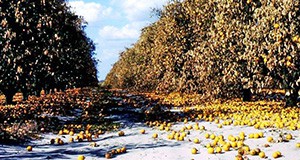
Citrus trees are evergreen, never become fully dormant, and cannot withstand temperatures as low as those tolerated by deciduous trees. But citrus trees can become preconditioned or acclimated to cool air temperatures that occur in late fall and winter. One of the best ways to lessen cold injury and to hasten recovery from cold damage is to maintain healthy trees. This five-page fact sheet discusses the symptoms of freeze damage and ways to help recover trees that have been damaged. Written by Mongi Zekri, Chris Oswalt, Steve Futch, Gary England, Camilly McAvoy, Laurie Hurner, and Parker Platts, and published by the Horticultural Sciences Department.
http://edis.ifas.ufl.edu/hs1250
Tag: Cold Protection and Chilling Damage in Citrus Production
SL296/SS509 Citrus Cold Weather Protection and Irrigation Scheduling Tools Using Florida Automated Weather Network (FAWN) Data
SL-296, an 8-page illustrated fact sheet by John L. Jackson, Kelly Morgan and William R. Lusher, provides an overview of the water saving tools that are available to citrus growers on the FAWN Web site — the Cold Protection Toolkit and the citrus microsprinkler irrigation scheduler. Published by the UF Department of Soil and Water Sciences, September 2009.
http://edis.ifas.ufl.edu/SS509